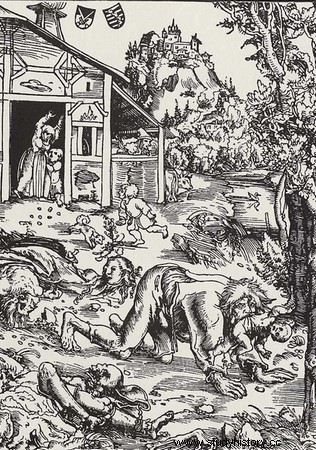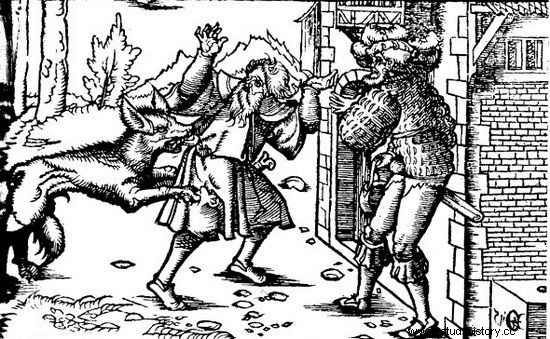The werewolf was disenchanted. Pop culture serves it in youth series, movies and games. In a word:everywhere. Today, no one trembles anymore at the approaching full moon, although just over 110 years ago it was different. The werewolves were scared for real.
Lycanthropy is commonly found in Slavic legends. For generations, tales of cruel beasts lurking in the darkness of the night were passed on from mouth to mouth. Among the common people - also in Poland! - belief in supernatural phenomena, including the existence of werewolves, strigoi and other ghouls stubbornly refused to go out of date.
On July 7, 1901, a beggar experienced the liveliness of the legends literally. In the small village of Myscowa, in today's Krosno poviat, people made their living mainly by farming and sheep breeding.

As you can see in this 16th-century engraving, German werewolves kidnapped children, while those of Podkarpacie were satisfied with sheep several hundred years later.
While the shepherds tended the herd grazing nearby the forest, the animals were suddenly attacked by a wolf. He jumped out of the trees, grabbed one sheep, and fled into the backwoods. The shepherds, wanting to save the animal entrusted to them, rushed after the kidnapper. When they almost grabbed him, the wolf managed to lose the pursuit at the crossroads. Instead, on the road suddenly appeared ... a local beggar, a certain Iwan Karczmarczyk .
Although the man was an infirm old man, walking from village to village on alms, the shepherds, unable to explain the whole situation otherwise, immediately took him for a werewolf who they believe has returned to his human form.
The alleged werewolf took a heavy punch from the shepherds. The men stubbornly demanded the return of the kidnapped sheep. The Karczmarczyk tried to escape, but the enraged herd keepers caught up with him in a hedge.
Dread to think how the whole thing would end (after all, the shepherds were convinced that they were abusing the insidious monster!) If the gendarme had not come. The officer saved the life of the guilty God, the alleged werewolf, and informed his superiors and the municipal court about the whole situation.

For the inhabitants of the village of Myscowa, the werewolf probably looked like the one from the 16th-century woodcut.
An investigation was carried out, the circumstances of the incident were examined, all witnesses were heard and finally the court ruled . All the accused were found guilty of brutally beating an innocent grandfather begging.

On November 25, 1901, the court sentenced them to ten and five days' imprisonment. As it turned out in the course of the proceedings, even the mayor of Myscowa, a certain Solenka, was convinced of the werewolf activity of Karczmarczyk and participated in the beating without any qualms.
As for Ivan Karczmarczyk himself, he was unlucky and lucky at the same time. At first he was in the wrong place, at an exceptionally bad time, and was accused of lycanthropy and was painfully shown what a deeply entrenched folk superstition meant. Later, for his luck (and the misfortune of the shepherds), a representative of the "glass and eye" appeared at the right moment, who did not believe the werewolf story and saved the beggar's life.
However, this is not the most important thing for us. If you believe Leszek Słupecki - the author of the book "Warriors and Werewolves" - Mr. Karczmarczyk was, first of all, a truly historical figure:the last Polish werewolf to be confirmed in any source! Or at least the last man suspected of it ...
Source:
Trivia is the essence of our website. Short materials devoted to interesting anecdotes, surprising details from the past, strange news from the old press. Reading that will take you no more than 3 minutes, based on single sources. This particular material is based on:
- L.P. Słupecki, Warriors and werewolves , Polish Scientific Publishers PWN, Warsaw 2011.
